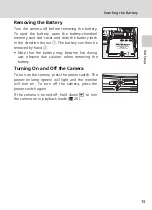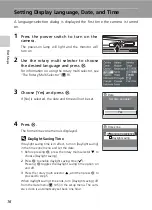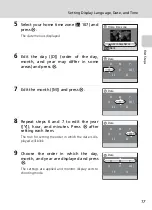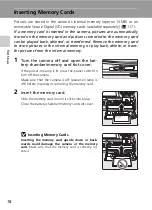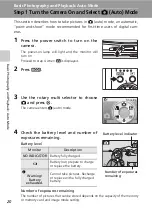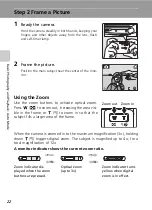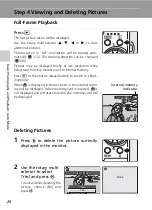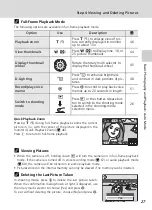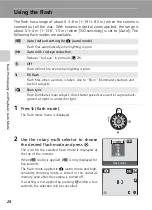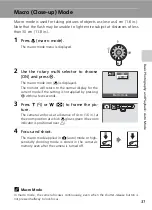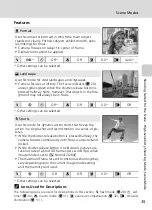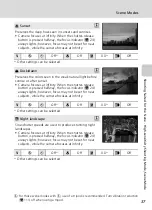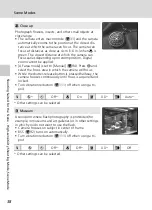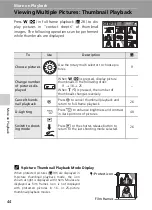
29
Using the Flash
Basic Phot
ograph
y and
Playbac
k: Aut
o
Mode
j
Shooting When Lighting Is Poor and the Flash Is Disabled (
B
)
• Use of a tripod is recommended to stabilize the camera during shooting and avoid the
effects of camera shake. Turn vibration reduction (
111) off when using a tripod.
• The
W
icon is displayed when the camera automatically increases sensitivity. Pictures taken
when
W
is displayed may be slightly mottled.
• When
W
is displayed and higher sensitivity is applied, noise reduction may be automatically
applied as pictures taken are recorded; results in increased recording times.
j
Note on Using the Flash
When using the flash at a wide-angle zoom position, reflections from dust particles in the air
may appear as bright spots in pictures. To reduce these reflections, set the flash mode to
B
(Off) or zoom in on the subject.
k
The AF-assist Illuminator
If lighting is poor, the AF-assist illuminator may light to assist the focus operation when the
shutter-release button is pressed halfway. The illuminator has a range of about 3.5 m (11 ft.
5.7 in.) at the maximum wide-angle position and about 3 m (9 ft. 10.1 in.) at the maximum
telescopic position. The AF-assist illuminator can be set to [Off] manually (
111), although
in this case the camera may not focus when lighting is poor.
k
The Flash Indicator and Flash Lamp
The flash indicator and flash lamp show flash sta-
tus when the shutter-release button is pressed half-
way.
•
On
: Flash will fire when picture is taken.
•
Blinks
: Flash charging. Wait a few seconds and
try again.
•
Off
: Flash will not fire when picture is taken.
When pictures are taken using the flash and a low battery, the monitor display will turn off
and the flash lamp will blink until the flash is fully charged.
k
Red-Eye Reduction
The COOLPIX S51 is equipped with an advanced red-eye reduction system. Pre-flashes are
fired several times at low intensity before the main flash to reduce “red-eye.” If the camera
detects “red-eye” after a picture is taken, Nikon’s own In-Camera Red-Eye Fix processes the
image as it is recorded. Therefore, there is a slight delay before the shutter-release button
operates normally to take another picture.
• Not recommended for when shutter-release timing is essential.
• Red-eye reduction may not always produce the desired results.
• In some rare cases, other portions of pictures may be affected.
Use flash modes other than auto with red-eye reduction in above cases.

